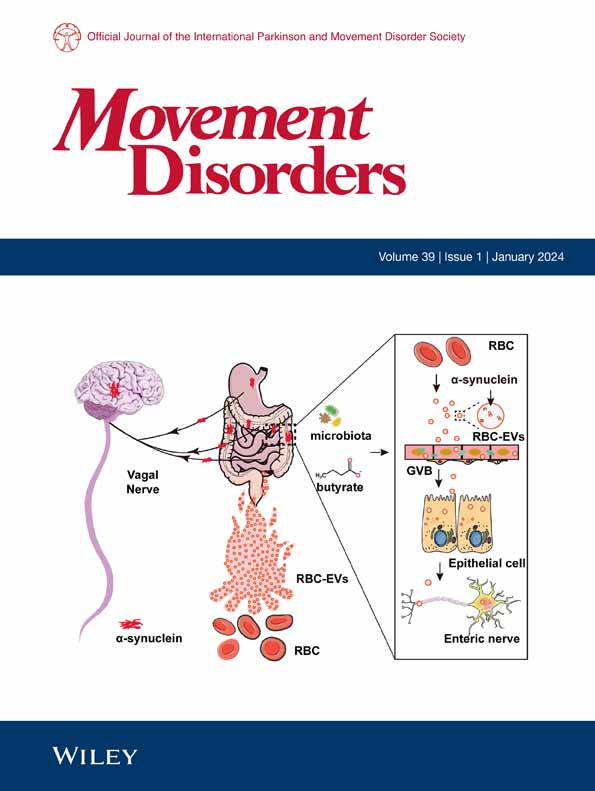Ralph Buchert PhD, Florian Wegner MD, Hans-Jürgen Huppertz MD, Georg Berding MD, Matthias Brendel MD, Ivayla Apostolova MD, Carsten Buhmann MD, Alexander Dierks MD, Sabrina Katzdobler MD, Martin Klietz MD, Johannes Levin MD, Nima Mahmoudi MD, Andreas Rinscheid PhD, Sophia Rogozinski MD, Jost-Julian Rumpf MD, Christine Schneider MD, Sophia Stöcklein MD, Phoebe G. Spetsieris PhD, David Eidelberg MD, Mike P. Wattjes MD, PhD, Osama Sabri MD, Henryk Barthel MD, Günter Höglinger MD, for the Alzheimer's Disease Neuroimaging Initiative
下载PDF
{"title":"在变异性进行性核上性麻痹中,自动协方差模式分析优于18F-氟脱氧葡萄糖正电子发射断层扫描(FDG-PET)的视觉读数","authors":"Ralph Buchert PhD, Florian Wegner MD, Hans-Jürgen Huppertz MD, Georg Berding MD, Matthias Brendel MD, Ivayla Apostolova MD, Carsten Buhmann MD, Alexander Dierks MD, Sabrina Katzdobler MD, Martin Klietz MD, Johannes Levin MD, Nima Mahmoudi MD, Andreas Rinscheid PhD, Sophia Rogozinski MD, Jost-Julian Rumpf MD, Christine Schneider MD, Sophia Stöcklein MD, Phoebe G. Spetsieris PhD, David Eidelberg MD, Mike P. Wattjes MD, PhD, Osama Sabri MD, Henryk Barthel MD, Günter Höglinger MD, for the Alzheimer's Disease Neuroimaging Initiative","doi":"10.1002/mds.29581","DOIUrl":null,"url":null,"abstract":"<div>\n \n \n <section>\n \n <h3> Background</h3>\n \n <p>To date, studies on positron emission tomography (PET) with <sup>18</sup>F-fluorodeoxyglucose (FDG) in progressive supranuclear palsy (PSP) usually included PSP cohorts overrepresenting patients with Richardson's syndrome (PSP-RS).</p>\n </section>\n \n <section>\n \n <h3> Objectives</h3>\n \n <p>To evaluate FDG-PET in a patient sample representing the broad phenotypic PSP spectrum typically encountered in routine clinical practice.</p>\n </section>\n \n <section>\n \n <h3> Methods</h3>\n \n <p>This retrospective, multicenter study included 41 PSP patients, 21 (51%) with RS and 20 (49%) with non-RS variants of PSP (vPSP), and 46 age-matched healthy controls. Two state-of-the art methods for the interpretation of FDG-PET were compared: visual analysis supported by voxel-based statistical testing (five readers) and automatic covariance pattern analysis using a predefined PSP-related pattern.</p>\n </section>\n \n <section>\n \n <h3> Results</h3>\n \n <p>Sensitivity and specificity of the majority visual read for the detection of PSP in the whole cohort were 74% and 72%, respectively. The percentage of false-negative cases was 10% in the PSP-RS subsample and 43% in the vPSP subsample. Automatic covariance pattern analysis provided sensitivity and specificity of 93% and 83% in the whole cohort. The percentage of false-negative cases was 0% in the PSP-RS subsample and 15% in the vPSP subsample.</p>\n </section>\n \n <section>\n \n <h3> Conclusions</h3>\n \n <p>Visual interpretation of FDG-PET supported by voxel-based testing provides good accuracy for the detection of PSP-RS, but only fair sensitivity for vPSP. Automatic covariance pattern analysis outperforms visual interpretation in the detection of PSP-RS, provides clinically useful sensitivity for vPSP, and reduces the rate of false-positive findings. Thus, pattern expression analysis is clinically useful to complement visual reading and voxel-based testing of FDG-PET in suspected PSP. © 2023 The Authors. <i>Movement Disorders</i> published by Wiley Periodicals LLC on behalf of International Parkinson and Movement Disorder Society.</p>\n </section>\n </div>","PeriodicalId":213,"journal":{"name":"Movement Disorders","volume":"38 10","pages":"1901-1913"},"PeriodicalIF":7.4000,"publicationDate":"2023-09-01","publicationTypes":"Journal Article","fieldsOfStudy":null,"isOpenAccess":false,"openAccessPdf":"https://onlinelibrary.wiley.com/doi/epdf/10.1002/mds.29581","citationCount":"1","resultStr":"{\"title\":\"Automatic covariance pattern analysis outperforms visual reading of 18F-fluorodeoxyglucose-positron emission tomography (FDG-PET) in variant progressive supranuclear palsy\",\"authors\":\"Ralph Buchert PhD, Florian Wegner MD, Hans-Jürgen Huppertz MD, Georg Berding MD, Matthias Brendel MD, Ivayla Apostolova MD, Carsten Buhmann MD, Alexander Dierks MD, Sabrina Katzdobler MD, Martin Klietz MD, Johannes Levin MD, Nima Mahmoudi MD, Andreas Rinscheid PhD, Sophia Rogozinski MD, Jost-Julian Rumpf MD, Christine Schneider MD, Sophia Stöcklein MD, Phoebe G. Spetsieris PhD, David Eidelberg MD, Mike P. Wattjes MD, PhD, Osama Sabri MD, Henryk Barthel MD, Günter Höglinger MD, for the Alzheimer's Disease Neuroimaging Initiative\",\"doi\":\"10.1002/mds.29581\",\"DOIUrl\":null,\"url\":null,\"abstract\":\"<div>\\n \\n \\n <section>\\n \\n <h3> Background</h3>\\n \\n <p>To date, studies on positron emission tomography (PET) with <sup>18</sup>F-fluorodeoxyglucose (FDG) in progressive supranuclear palsy (PSP) usually included PSP cohorts overrepresenting patients with Richardson's syndrome (PSP-RS).</p>\\n </section>\\n \\n <section>\\n \\n <h3> Objectives</h3>\\n \\n <p>To evaluate FDG-PET in a patient sample representing the broad phenotypic PSP spectrum typically encountered in routine clinical practice.</p>\\n </section>\\n \\n <section>\\n \\n <h3> Methods</h3>\\n \\n <p>This retrospective, multicenter study included 41 PSP patients, 21 (51%) with RS and 20 (49%) with non-RS variants of PSP (vPSP), and 46 age-matched healthy controls. Two state-of-the art methods for the interpretation of FDG-PET were compared: visual analysis supported by voxel-based statistical testing (five readers) and automatic covariance pattern analysis using a predefined PSP-related pattern.</p>\\n </section>\\n \\n <section>\\n \\n <h3> Results</h3>\\n \\n <p>Sensitivity and specificity of the majority visual read for the detection of PSP in the whole cohort were 74% and 72%, respectively. The percentage of false-negative cases was 10% in the PSP-RS subsample and 43% in the vPSP subsample. Automatic covariance pattern analysis provided sensitivity and specificity of 93% and 83% in the whole cohort. The percentage of false-negative cases was 0% in the PSP-RS subsample and 15% in the vPSP subsample.</p>\\n </section>\\n \\n <section>\\n \\n <h3> Conclusions</h3>\\n \\n <p>Visual interpretation of FDG-PET supported by voxel-based testing provides good accuracy for the detection of PSP-RS, but only fair sensitivity for vPSP. Automatic covariance pattern analysis outperforms visual interpretation in the detection of PSP-RS, provides clinically useful sensitivity for vPSP, and reduces the rate of false-positive findings. Thus, pattern expression analysis is clinically useful to complement visual reading and voxel-based testing of FDG-PET in suspected PSP. © 2023 The Authors. <i>Movement Disorders</i> published by Wiley Periodicals LLC on behalf of International Parkinson and Movement Disorder Society.</p>\\n </section>\\n </div>\",\"PeriodicalId\":213,\"journal\":{\"name\":\"Movement Disorders\",\"volume\":\"38 10\",\"pages\":\"1901-1913\"},\"PeriodicalIF\":7.4000,\"publicationDate\":\"2023-09-01\",\"publicationTypes\":\"Journal Article\",\"fieldsOfStudy\":null,\"isOpenAccess\":false,\"openAccessPdf\":\"https://onlinelibrary.wiley.com/doi/epdf/10.1002/mds.29581\",\"citationCount\":\"1\",\"resultStr\":null,\"platform\":\"Semanticscholar\",\"paperid\":null,\"PeriodicalName\":\"Movement Disorders\",\"FirstCategoryId\":\"3\",\"ListUrlMain\":\"https://onlinelibrary.wiley.com/doi/10.1002/mds.29581\",\"RegionNum\":1,\"RegionCategory\":\"医学\",\"ArticlePicture\":[],\"TitleCN\":null,\"AbstractTextCN\":null,\"PMCID\":null,\"EPubDate\":\"\",\"PubModel\":\"\",\"JCR\":\"Q1\",\"JCRName\":\"CLINICAL NEUROLOGY\",\"Score\":null,\"Total\":0}","platform":"Semanticscholar","paperid":null,"PeriodicalName":"Movement Disorders","FirstCategoryId":"3","ListUrlMain":"https://onlinelibrary.wiley.com/doi/10.1002/mds.29581","RegionNum":1,"RegionCategory":"医学","ArticlePicture":[],"TitleCN":null,"AbstractTextCN":null,"PMCID":null,"EPubDate":"","PubModel":"","JCR":"Q1","JCRName":"CLINICAL NEUROLOGY","Score":null,"Total":0}
引用次数: 1
引用
批量引用


 求助内容:
求助内容: 应助结果提醒方式:
应助结果提醒方式:


